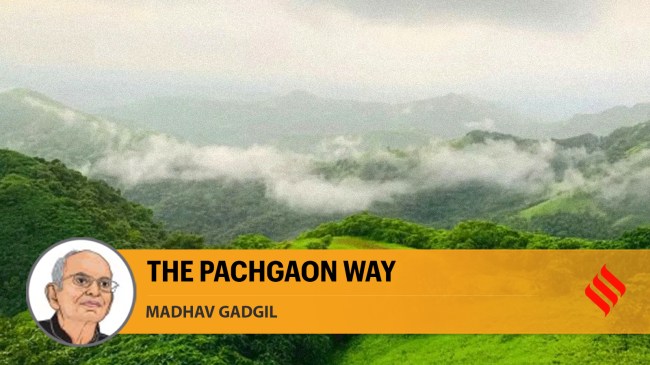Opinion For renewal of Western Ghats, put people at the centre
The process of democratic decentralisation should help in the region’s ecological revival
 The entire region is crying out for an honest implementation of the Forest Rights Act and assignment of Community Forest Rights to a substantial proportion of the population that has been living inside forests or on their fringes for over three generations.
The entire region is crying out for an honest implementation of the Forest Rights Act and assignment of Community Forest Rights to a substantial proportion of the population that has been living inside forests or on their fringes for over three generations. The National Mission for a Green India bases its estimates and proposals for action on the information provided by the Forest Survey of India (FSI), and its execution by the Forest Department (FD). Regrettably, FSI data is quite outdated, available on a crude scale and deliberately distorted. At the same time, the FD, an anti-science, anti-nature, anti-people agency, will never end up greening the Western Ghats. What we need instead is a different science-based, nature-centric and people-oriented approach.
I came to understand the way the FD manages its affairs as a result of M Y Ghorpade, then Karnataka’s finance minister, being gheraoed by basket weavers in 1975. The weavers were complaining about the excessive cutting of bamboo by the paper industry in the state, which was adversely affecting their livelihoods. Ghorpade decided that an objective evaluation was required and asked me to undertake the task. This took me to the West Coast Paper Mills (WCPM) at Dandeli, in the district of Uttara Kannada in Karnataka.
My mandate was to investigate whether bamboo resources had indeed been depleted and assess afresh the resource position, based on the data available from the FD’s “Pre-Investment Survey of Forest Resources” (PISFR), WCPM, and our own fresh fieldwork. These field studies revealed the PISFR figures to be overestimates by a factor of 10. This inflated figure for bamboo had provided a justification for setting up one more paper mill. We were able to reassess the bamboo stocks in the field because detailed information, disaggregated to the level of forest compartments (a geographically defined and permanently demarcated unit of forest land, used for management, planning, and record-keeping purposes), was made available to us. This would not have been possible if we had access only to highly aggregated data such as at a district or division level, which is all that is available to the general public as official statistics.
In 1972, Satish Dhawan became the chairman of the Indian Space Research Organisation (ISRO). In July that year, satellite imagery of Earth became available with the launch of the Landsat programme. Dhawan immediately set up the National Remote Sensing Centre (NRSC) in Hyderabad to undertake and facilitate remote-sensing activities in the country. One of the early projects of NRSC was to interpret the 1972–75 Landsat imagery to assess the forest cover of the country. The results of the NRSC study were startlingly at variance with FD’s official information. While the FD claimed that 23 per cent of the country was under forest cover, remote-sensing imagery showed that the forest cover was much less, only about 15 per cent. The government forthwith ordered NRSC to stop its assessment and set up the FSI as the exclusive agency to do so. The FSI provides data at highly aggregated levels, such as at that of districts, and after a delay of two or three years. There is absolutely no justification for data continuing to be so delayed and aggregated in the day and age of Google Earth and other satellite data that are freely available to all members of the public in real time and at scales as fine as 10 hectares.
There are other instances, too. Earlier, in 1963, the Grasim rayon factory began producing pulp and fibre in Mavoor, on the banks of the Chaliyar river in Kerala’s Kozhikode district. The management neglected to adopt any pollution-control measures citing profitability concerns and recklessly released poisonous effluents into the river, adversely impacting its fish and clam population and human health. It turned out that the effluent had high levels of poisonous mercury, lead, nickel, cobalt, iron, chromium zinc and copper. The factory was supplied bamboo at a throwaway price of Re 1 per tonne when its market price was Rs 1,400 per tonne. It led to the destruction of 10,000 hectares of bamboo forests in Wayanad. As stocks of bamboo became depleted, Grasim came to depend on eucalyptus, and the government promoted eucalyptus and Australian acacia plantations, accompanied by large-scale use of pesticides in the forest areas. Together, it led to the destruction of natural resources and human suffering with the active knowledge and collusion of the FD.
What, then, should we do? Pachgaon in Maharashtra’s Chandrapur district shows the way. Pachgaon was assigned Community Forest Rights (CFR) under the Forest Rights Act of 2006 over 1,000 ha of land. It is exercising this right to good effect. Through bamboo sales, Pachgaon earns a good income. So its people have stopped setting fire to tendu leaves to stimulate fresh growth. This is despite the fact that tendu leaves, too, were a good source of income. Additionally, they have voluntarily set aside 30 hectares as a sacred grove. With this, the forest is registering healthy growth and sequestering large quantities of carbon. This has also meant security of livelihoods and greater self-respect for the people. Earlier, many villagers used to migrate all the way to Gujarat to earn a living. Now, very few people leave the village.
This is clearly the way forward for effectively greening the Western Ghats. The entire region is crying out for an honest implementation of the Forest Rights Act and assignment of Community Forest Rights to a substantial proportion of the population that has been living inside forests or on their fringes for over three generations. At the same time, we should take forward the process of democratic decentralisation and involve people in the decision-making process. This is what the Western Ghats Ecology Expert panel advocated and I wish to reassert that this, indeed, is the way ahead.
The writer is an ecologist






